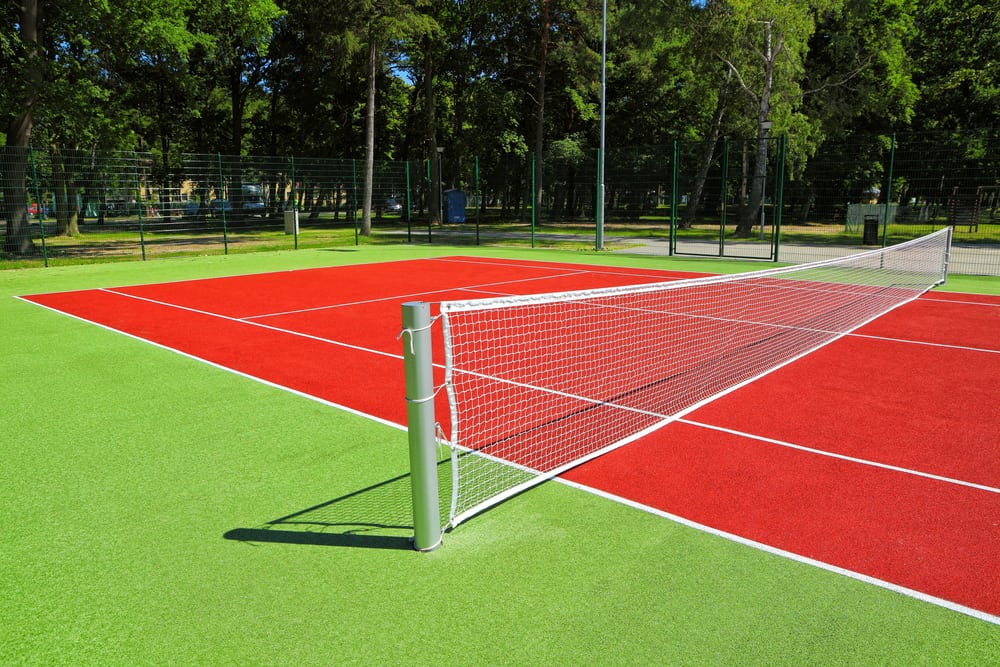Tennis courts provide a platform for players to compete and showcase their skills. The type of surface that a tennis court is made of can significantly impact how the game is played, as each surface has unique characteristics and requires different strategies and techniques. This article will discuss and analyze the three main types of tennis court surfaces: hard, clay, and grass, and examine their composition, characteristics, advantages, and disadvantages.
POINTS
- Tennis courts have evolved over time to meet changing needs and preferences.
- There are three main types of tennis court surfaces: hard, clay, and grass.
- Hard courts are made of various materials, including asphalt, concrete, or acrylic. They have a medium-to-high bounce and are known for their quick pace.
- Clay courts are made of crushed shale, stone, or brick and have a medium-to-high bounce. They are known for their slower pace.
- Grass courts are made of natural grass and have a fast pace with low bounce.
Brief history of tennis court surfaces and their evolution over time
The game of tennis has been played for centuries, and over time, the courts’ surface has evolved to meet players’ changing needs and preferences. In the sport’s early days, tennis was played on various surfaces, including grass, dirt, and wood. As it developed and became more professionalized, multiple materials and technologies were introduced to create more consistent and reliable surfaces.
Overview of the three main types of tennis court surfaces
Today, there are three main types of tennis court surfaces: hard, clay, and grass. Hard courts are the most common surface type and are found in many settings, from professional tournaments to local parks. Clay courts are the second most common surface type, known for their slower pace and higher bounce. Grass courts are the least common type of surface, characterized by their fast speed and low bounce.
Detailed description of hard courts
Hard courts are made of various materials, including asphalt, concrete, or acrylic, and are known for their consistent and reliable surface. They are typically composed of a layer of asphalt or concrete topped with a layer of acrylic, a type of synthetic material applied to the surface to provide a consistent and durable playing surface. Hard courts have a medium-to-high bounce and are known for their quick pace, which requires players to be speedy and agile.
An advantage of hard courts is that they require pretty low maintenance and can withstand heavy usage. They are also relatively easy to repair, as any damage can be patched or resurfaced. However, hard courts can be unforgiving on the body, as the surface is hard and does not offer much cushioning. This can lead to increased wear and tear on players’ joints and muscles, mainly if they are not in good physical condition.
Detailed description of clay courts
On the other hand, clay courts are made of crushed shale, stone, or brick and are known for their slower pace and higher bounce. The surface of a clay court is made up of a layer of crushed shale, stone, or brick, then topped with a layer of fine clay. The clay is carefully maintained and rolled to create a smooth and consistent playing surface. Clay courts have a medium-to-high bounce and are known for their slower pace, which requires players to be patient and strategic.
This surface type is relatively gentle on players’ bodies, as the surface is softer and provides more cushioning than hard courts. This can be especially beneficial for players who are recovering from injuries or are prone to joint or muscle problems.
One downside of clay courts is that they are more susceptible to weather-related issues, such as rain or heat, which can affect the consistency and quality of the playing surface. Clay courts also require more maintenance and upkeep than hard courts, as the surface must be carefully maintained and rolled to ensure a consistent playing surface.
Detailed description of grass courts
Grass courts are made of natural grass and are the least common type of tennis court surface. They are characterized by their fast pace and low bounce and are known for their natural beauty and traditional appeal. The surface of a grass court is made up of a layer of natural grass, which is carefully maintained and manicured to create a smooth and consistent playing surface.
Grass courts offer a unique and challenging playing experience that requires players to be quick and agile. The fast pace and low bounce of grass courts also encourage players to have excellent footwork, court coverage, and a good feel for the ball. This material presents a softer and more forgiving surface than hard or clay courts, which can benefit players’ bodies and help reduce the risk of injuries.
Unfortunately, grass courts have several disadvantages compared to other types of surfaces. They are the most susceptible to weather-related issues, such as rain and heat, which can affect the consistency and quality of the playing surface.
Grass courts also require more maintenance and upkeep than hard or clay courts, as the grass must be carefully maintained and watered to ensure a consistent playing surface. In addition, grass courts are more prone to wear and tear, as the surface can become uneven or rutted over time.
Comparison of the advantages and disadvantages of each type of tennis court surface
Hard, clay, and grass courts each have unique characteristics, advantages, and disadvantages. Here is a quick summary of the main differences between the three types of surfaces:
1. Hard courts
Advantages:
- Fast pace
- Consistent and reliable surface
- Low maintenance and easy to repair
Disadvantages:
- Hard surfaces can be unforgiving on players’ bodies
- Susceptible to heat and sun damage
- It may not offer as much strategic variety as other surfaces
2. Clay courts
Advantages:
- Softer and more forgiving surface
- The slower pace allows for more strategic play
- It can be beneficial for players with injuries or joint issues
Disadvantages:
- Susceptible to weather-related issues
- More maintenance and upkeep required
- A slower pace may not suit all playing styles
3. Grass courts
Advantages:
- The fast pace and low bounce require quick and agile play
- Natural beauty and traditional appeal
- Softer and more forgiving surface
Disadvantages:
- Susceptible to weather-related issues
- More maintenance and upkeep required
- Prone to wear and tear
- It may not suit all playing styles
FAQ
What is the best surface for a tennis court?
There is no “best” surface for a tennis court, as each type of surface has its unique characteristics, advantages, and disadvantages. The best surface for a tennis court depends on the preferences and needs of the players, as well as the climate and conditions of the location.
Are clay tennis courts slower?
Clay courts are generally slower than hard or grass courts, as the surface is softer and has a higher bounce. This can lead to longer rallies and a slower pace of play, which may be more suited to players who prefer a strategic and patient style of play.
Conclusion
Tennis courts are essential for consistent matches, and the type of surface a court is made of can significantly impact how the game is played. Hard courts, clay courts, and grass courts have their unique characteristics, advantages, and disadvantages.
While no “perfect” surface is suitable for all players, players need to consider their strengths and weaknesses, as well as their goals and preferences, when choosing a surface to play on. Some players may prefer the fast pace and low maintenance of hard courts, while others may prefer the slower pace and strategic challenges of clay courts. Grass courts may be more suited to players looking for a unique and challenging playing experience or who appreciate their traditional and natural appeal. Next time you go out to play tennis, take our advice and choose your court surface wisely!
 Written by Mark Sampson
Written by Mark Sampson